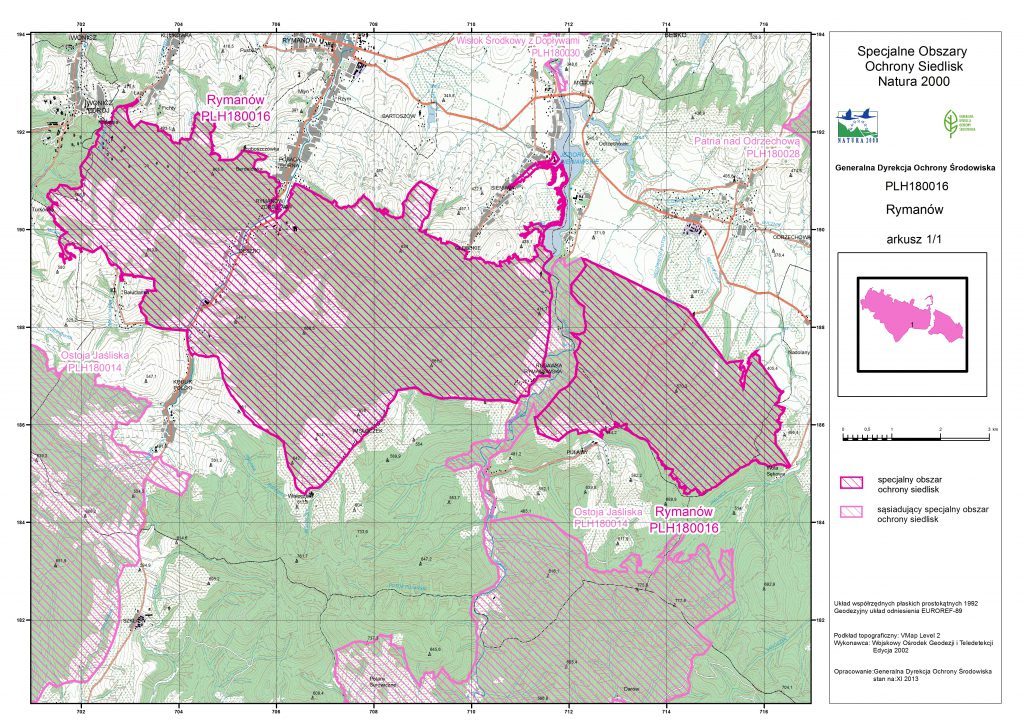Description of the area:
The area stretches between Iwonicz Zdrój in the west and Wola Sękowa in the east. In terms of geobotanics, it belongs to the Land of the Eastern Carpathians, the Low Beskid Region (the sub-district of the Low Eastern Beskids “Łupków Pass-Dukla Pass”). Small sections in the northern and western part of the Area belong to the district of Jasło-Sanok Valleys, sub-district of Dukla (Matuszkiewicz 2008). It was designated for the protection of bat breeding colonies (the greater mouse-eared bat Myotis myotisi and the lesser horseshoe bat Rhinolophus hipposideros) located in two religious buildings: St. Stanislaw Bishop and Martyr Church in Rymanów Zdrój (stone church from 1926 located on the banks of the Tabor River in the vicinity of the Town Park and a busy regional road No. 889) and the Our Lady of Częstochowa Church in Sieniawa (a wooden church from 1874, placed on the bank of the dammed reservoir in Sieniawa). It also includes the feeding area of both colonies.
The church in Rymanów Zdrój:
The church in Rymanów Zdrój is located in the close vicinity of the Tabor River, the Town Park and the busy regional road No. 889. The building is covered with a sheet of metal and is lit by several spotlights at night. The attic of the church, where the breeding colony is located, is secured with a platform protecting the church’s ceiling against bat guano. The history of the spa temple is closely related to the history of the health resort, and these dates back to the second half of the 19th century. The first, wooden chapel for patients was located on the right bank of Tabor River below Łazienki Zdrojowe. The construction of the stone chapel, which had started before World War I, was completed in 1926. The temple was consecrated by the priest and bishop Karol Józef Fisher. Until 1939, the chapel was a place of prayer only for spa resort guests. During World War II, the church was open to all the believers throughout the year. In 1964, the Sisters of Charity of St. Vincent de Paul – Daughters of Charity, who to this day lead the spiritual formation of girls and religious education. On 3rd February 1974, the bishop of Przemyśl, Ignacy Tokarczuk, established the parish of St. Stanislaw Bishop in Rymanów-Zdrój, appointing the priest Franciszek Pener, to be the first parish priest. The parish priest carried out further renovations and decorations of the church with the support of parishioners.
The church in Sieniawa:
The church in Sieniawa is situated on the bank of the dammed reservoir on the Wisłok River. In the immediate vicinity of the building there are rural buildings, meadows, fields and mixed forests. The former Greek Catholic Church of the Nativity of the Mother of God in Sieniawa was erected in 1874. From the end of World War II in 1947–1953, there was a warehouse in the building. Today it is a Roman Catholic church, completely renovated in 1972. A wooden, non-oriented temple of a log frame structure, situated on a stone foundation, was built in the Lemko style of the north-eastern type. The church is situated on the burial cemetery and is surrounded by a wall of broken stone. In the tri-partite interior, a rectangular, narrower, south-facing chancel is separated from the rectangular nave. A rectangular sacristy connects to the chancel from the east. From the north, a narrower, almost square temple porch is adjacent to the nave, with a large church porch at the front. Above the temple porch there is a music choir with a corrugated windowsill. The single-ridge three-slope roof with turrets is covered with a sheet metal, above the church porch there is a two-story tower with an eight-sided tented roof. Above the chancel there is a six-sided tower with a lantern for a ridge turret, covered by a tented roof with an iron cross from 1874. The front elevation is finished with a curved, cut abutment. Inside, the ceilings are flat, the walls are decorated with ornamental and representative polychromes. A Russian folk processional cross from the 19th century hangs on the rood beam, there are also remains of the iconostasis, three altars from around 1900 and a tin candlestick for the paschal candle. Nearby, in the northern part of the cemetery, there is a stone and plastered two-story belfry built on a square plan in 1847. Its upper storey with three arcades is separated by a cornice. Its roof is tented, mansard, covered with sheet metal, finished with a sphere with a cross.
Area: 5241.0 ha
Administrative location: Podkarpackie Voivodeship: Krosno district, town and commune of Iwonicz Zdrój, commune of Rymanów (places: Bałucianka, Deszno, Głębokie, Klimkówka, Królik Polski, Posada Górna, Puławy, Rudawka Rymanowska, Rymanów Zdrój, Sieniawa, Tarnawka, Wólka, Wisłoczek , Wołtuszowa), Sanok district, communes: Bukowsko (place: Wola Skowa), Zarszyn (place: Odrzechowa).



